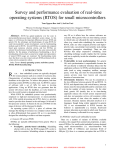Download www.cis.ksu.edu - People - Kansas State University
Transcript
KERNEL IMPLEMENTATION OF
MONITORS FOR ERIKA
by
SATHISH KUMAR R. YENNA
B.Tech., Jawaharlal Nehru Technological University, India, 2001
A THESIS
submitted in partial fulfillment of the
requirements for the degree
MASTER OF SCIENCE
Department of Computing and Information Sciences
College of Engineering
KANSAS STATE UNIVERSITY
Manhattan, Kansas
2003
Approved By
Major Professor
Mitchell L. Neilsen
Copyright (c) 2003 Sathish Kumar R. Yenna. Permission is granted to copy,
distribute and/or modify this document under the terms of the GNU Free Documentation License, Version 1.1 or any later version published by the Free Software
Foundation; with no Invariant Sections, with no FrontCover Texts, and with no
BackCover Texts.
This document is prepared using LATEX.
ABSTRACT
ERIKA (Embedded Real tIme Kernel Architecture) is a research project on
micro-kernel architectures for embedded systems. Users can develop embedded
applications on ERIKA without worrying about the underlying architectural and
implementation details. Monitors are program modules that provide a structured
approach for process synchronization and can be implemented as efficiently as
semaphores. ERIKA presently supports basic mutual exclusion primitives and
semaphores for thread synchronization. It does not support monitors, which provide an efficient data abstraction mechanism. This thesis is about implementing
monitors for ERIKA using the available kernel primitives. This implementation
enables users to directly declare, define and use monitors in their applications.
TABLE OF CONTENTS
ABSTRACT
ACKNOWLEDGEMENTS
vi
1 Introduction to ERIKA
1
1.1 Architecture . . . . . . . . . . . . . . . . . . . . . . . . . . . . . . .
2
1.2 Thread Handling . . . . . . . . . . . . . . . . . . . . . . . . . . . .
2
1.3 Thread Synchronization . . . . . . . . . . . . . . . . . . . . . . . .
4
1.4 Interrupt Handling . . . . . . . . . . . . . . . . . . . . . . . . . . .
4
1.5 Layers . . . . . . . . . . . . . . . . . . . . . . . . . . . . . . . . . .
5
1.5.1
The Kernel Layer . . . . . . . . . . . . . . . . . . . . . . . .
5
1.5.2
The Hardware Abstraction Layer . . . . . . . . . . . . . . .
6
1.6 System Modules . . . . . . . . . . . . . . . . . . . . . . . . . . . . .
9
1.7 Code Portability . . . . . . . . . . . . . . . . . . . . . . . . . . . . 10
2 Kernel API
11
2.1 Thread management . . . . . . . . . . . . . . . . . . . . . . . . . . 12
2.2 Thread Management in Interrupt Handlers . . . . . . . . . . . . . . 14
2.3 Shared Resource Handling . . . . . . . . . . . . . . . . . . . . . . . 14
i
2.4 Utility Functions . . . . . . . . . . . . . . . . . . . . . . . . . . . . 15
2.5 The dummy() thread . . . . . . . . . . . . . . . . . . . . . . . . . . 16
3 Kernels
20
3.1 FP Kernel . . . . . . . . . . . . . . . . . . . . . . . . . . . . . . . . 20
3.1.1
An Example . . . . . . . . . . . . . . . . . . . . . . . . . . . 21
3.2 SRPT Kernel . . . . . . . . . . . . . . . . . . . . . . . . . . . . . . 22
4 HAL Internals
25
4.1 HAL Interface . . . . . . . . . . . . . . . . . . . . . . . . . . . . . . 26
4.2 Context Handling . . . . . . . . . . . . . . . . . . . . . . . . . . . . 28
4.3 Kernel Primitive Definition . . . . . . . . . . . . . . . . . . . . . . . 29
4.4 Interrupt Handling . . . . . . . . . . . . . . . . . . . . . . . . . . . 30
4.5 Utility Functions . . . . . . . . . . . . . . . . . . . . . . . . . . . . 30
5 ST10 HAL Internals
35
5.1 Peculiarities of the ST10 Implementation . . . . . . . . . . . . . . . 36
5.2 Multi-Stack HAL . . . . . . . . . . . . . . . . . . . . . . . . . . . . 38
5.2.1
Internal data structures defined by the user . . . . . . . . . 38
5.2.2
Context Layout . . . . . . . . . . . . . . . . . . . . . . . . . 39
5.2.3
Stack Implementation . . . . . . . . . . . . . . . . . . . . . 40
5.2.4
Performance . . . . . . . . . . . . . . . . . . . . . . . . . . . 41
6 Monitors
43
6.1 Programming Using Monitors . . . . . . . . . . . . . . . . . . . . . 44
6.2 Synchronization in Monitors . . . . . . . . . . . . . . . . . . . . . . 45
6.3 Implementation Using a Kernel . . . . . . . . . . . . . . . . . . . . 47
ii
7 Implementation of Monitors
50
7.1 Data Structures . . . . . . . . . . . . . . . . . . . . . . . . . . . . . 50
7.1.1
Monitor Descriptor . . . . . . . . . . . . . . . . . . . . . . . 50
7.1.2
Condition Variable Descriptor . . . . . . . . . . . . . . . . . 51
7.2 Kernel Primitives . . . . . . . . . . . . . . . . . . . . . . . . . . . . 52
8 Monitor Interface
55
8.1 Monitor/Condition Variable Initialization . . . . . . . . . . . . . . . 55
8.2 Another Example . . . . . . . . . . . . . . . . . . . . . . . . . . . . 56
8.3 The Functions . . . . . . . . . . . . . . . . . . . . . . . . . . . . . . 56
9 Conclusion
59
Bibliography
60
Appendix
61
A Source Code
61
A.1 mon.h . . . . . . . . . . . . . . . . . . . . . . . . . . . . . . . . . . 61
A.2 enter.c . . . . . . . . . . . . . . . . . . . . . . . . . . . . . . . . . . 62
A.3 exit.c . . . . . . . . . . . . . . . . . . . . . . . . . . . . . . . . . . . 64
A.4 wait.c . . . . . . . . . . . . . . . . . . . . . . . . . . . . . . . . . . 65
A.5 signal.c . . . . . . . . . . . . . . . . . . . . . . . . . . . . . . . . . . 66
A.6 signalall.c . . . . . . . . . . . . . . . . . . . . . . . . . . . . . . . . 68
iii
LIST OF FIGURES
1.1 Layers of ERIKA. . . . . . . . . . . . . . . . . . . . . . . . . . . . .
5
2.1 Thread Transition Diagram [1]. . . . . . . . . . . . . . . . . . . . . 17
2.2 Context changes due to the activation of thread B that has higher
priority with respect to the running thread A [1]. . . . . . . . . . . 18
2.3 Context switches due to the activation of thread B by a call of
thread make ready() by a lower priority thread A [1]. . . . . . . . . 19
3.1 Kernel Data structures snapshot after the events listed [1]. . . . . . 23
4.1 Interaction between the kernel layer primitives and the HAL functions for context handling [1]. . . . . . . . . . . . . . . . . . . . . . 32
4.2 Context change due to the activation of a thread B at higher priority
with respect to the running thread A [1]. . . . . . . . . . . . . . . . 33
4.3 Context change caused by the activation of two higher priority
threads with respect to the running thread [1]. . . . . . . . . . . . . 34
5.1 Typical Stack layout of a preempted thread [1]. . . . . . . . . . . . 39
5.2 A typical stack configuration [1]. . . . . . . . . . . . . . . . . . . . . 40
6.1 Monitor Kernel Primitives [4]. . . . . . . . . . . . . . . . . . . . . . 49
iv
LIST OF TABLES
2.1 Kernel primitives that can be used in an application [1].
. . . . . . 11
3.1 The example thread set [1]. . . . . . . . . . . . . . . . . . . . . . . 21
4.1 The Basic HAL Interface [1]. . . . . . . . . . . . . . . . . . . . . . . 27
5.1 Characteristics of the ST10 HALs [1]. . . . . . . . . . . . . . . . . . 36
5.2 Performance metrics of the multi-stack ST10 kernel [1]. . . . . . . . 42
v
ACKNOWLEDGEMENTS
First of all, I would like to thank my major professor, Dr. Mitch Neilsen, for
allowing me to do this thesis under his guidance. I am grateful to him for all the
advice, encouragement and support he provided me with. I wish to thank him for
believing in me and providing me the opportunity to work with him as a Graduate
Research Assistant.
Next, I would like to thank Dr. Masaaki Mizuno, for being a continual source
of inspiration and encouragement, and Dr. Gurdip Singh, for kindly consenting to
be on my committee.
Also, I want to thank my parents, for always believing in me and for allowing
me to take chances, and I thank my friends for their invaluable support and for
their warm wishes.
Finally, I thank God for giving me the oppportunity to pursue a dream, and
for always being there for me when I needed.
vi
DEDICATION
To My Parents
vii
Chapter 1
Introduction to ERIKA
ERIKA (Embedded Real tIme Kernel Architecture) [1] is a research project on
micro-kernel architectures for embedded systems. ERIKA is composed of a set of
kernels and a set of tools:
- a scheduling simulator, that can be used to simulate the scheduling behavior
of the system
- a set of optimized algorithms, which help the designer to find an optimal
assignment of scheduling parameters that minimize the RAM usage while
maintaining the schedulability of the system.
ERIKA Kernels consist of two layers: the Kernel Layer and the Hardware Abstraction Layer (HAL). The Kernel Layer contains a set of modules that implement task
management and real-time scheduling policies. The Hardware Abstraction Layer
contains the hardware dependent code that handles context switches and interrupt
handling. Currently, there are HALs for the Seimens ST10/C167 architecture and
for the ARM7TDMI architecture. It is easy to port ERIKA to a new processor
family in a very short time by writing the HAL routines for the new architecture.
1
The interface is identical for all the implementations of the operating system, in
order to allow portability and re-usability of application software.
1.1
Architecture
The following paragraphs describe the architecture of the ERIKA from a functional
point of view.
A Kernel represents the core of a Real Time Operating System, which is a
software layer that directly interacts with the hardware on which the application
program runs. The main purpose of the Kernel is to give the application an interface capable to handle a set of entities that tries to abstract from the peculiarities
of the underlying hardware.
The ERIKA kernel is able to
- Handle threads (a thread is a function which is executed concurrently with
other entities in the system)
- Handle synchronization between threads (threads can share information by
communicating with each other)
- Handle interrupts (an interrupt is a mechanism used to signal a running
thread asynchronously)
1.2
Thread Handling
A multiprogramming environment provides entities that can execute concurrently.
These entities are called threads, processes, and tasks. The term process is usually
2
used to identify an address space with one or more threads executing within that
address space. The term thread can be thought as a single flow of control within a
process. The term task is used in the real-time literature with different meanings.
ERIKA does not support any kind of memory protection, so we can say that the
ERIKA kernel can handle a set of threads. The ERIKA Operating System can be
thought as a single process with many threads executing within the same address
space.
The ERIKA kernel provides only the basic features for thread handling: it
implements a real-time scheduling algorithm, a thread activation service and all
of the underlying context switching functions.
Each thread owns a set of attributes (body function, priority, user stack, registers, etc.) that identify the state of the thread. Each thread is associated with a
status word, which describes the state of the thread with respect to the scheduling
algorithm. In ERIKA a thread can be in one of the following four states:
- Stacked: The thread, t started its execution, and its frame is currently allocated on its stack; that is, t is the running thread or t has been preempted
by another thread.
- Ready: The task has been activated and is ready to execute. All ready tasks
are queued in a data structure called ready queue.
- Idle: The last instance of thread t has terminated and t is not queued on the
ready queue. Moreover, t does not have any memory allocated on its stack.
A task in the idle state is usually is waiting for activation.
- Blocked: This state is used when a task is blocked on a synchronizing condition. Note that this state is meaningful only in a multi-stack HAL, where
a thread can be blocked without interrupting others.
3
1.3
Thread Synchronization
The ERIKA kernel supports some synchronization mechanisms that can be used
to guarantee that some critical code sections are executed in mutual exclusion, and
other synchronization mechanisms that can be used for thread communication.
ERIKA system provides a type MUTEX and two mutex primitives, mutex lock()
and mutex unlock(), that can be used to set the boundaries of critical regions.
There are also blocking primitives implemented, such as classic semaphores and
Cyclical Asynchronous Buffers (CABs). The ERIKA distribution does not support
monitors, which is the main topic of this document.
1.4
Interrupt Handling
The ERIKA kernel can be configured to directly interact with the underlying
hardware architecture. In particular, it can handle the interrupts that are raised
by the I/O interfaces, timers, and so on in a clean way. In fact it provides an
interface that allows linking a handler written by the user into an interrupt vector.
That interface also provides proper handling of eventual interrupt controllers that
may be present in a particular architecture.
The handler can be considered a special function that can call a subset of the
primitives. These primitives can be used to interact with the operating system, for
example, activating a thread that will terminate the interaction with the hardware
interface. In this way, urgent pieces of code can be put directly into the handler.
On the other hand, less urgent tasks can be processed in a separated thread without
interfering the high priority tasks.
4
1.5
Layers
Two main layers compose the ERIKA kernel:
Kernel Layer: This layer is the software layer that exports all of the system
primitives to the application. It is written using the C programming language in
a way independent from the underlying architecture. This layer uses the services
offered by the HAL for thread and hardware interface handling.
Hardware Abstraction Layer (HAL): HAL is the software layer used by
the Kernel Layer to abstract from a particular architecture. This is the only
nonportable part of the system, and it isolates all the peculiarities of the underlying
architecture from the implementation of the behavior of the primitives. All HAL
primitives are related to low-level aspects like context switching and interrupt
handling. All other levels use the primitives provided by the HAL. Porting the
ERIKA kernel to another architecture requires only modification of the HAL.
Figure 1.1: Layers of ERIKA.
Application Layer (user tasks)
Kernel Layer (hardware independent routines)
Hardware Abstraction Layer (hardware dependent routines)
1.5.1
The Kernel Layer
The functions provided by the Kernel Layer can be grouped in:
Queue Handling: The kernel uses some queue data structures to keep track of
the state of all threads in an application. The functions for queue management cannot be called directly by the application, but only from inside the
5
kernel. The queues are usually ordered.
Scheduling: The kernel uses some extra functions to schedule the threads in
the system. These functions use the HAL interface and the queue handling
functions. These functions are not directly accessible to the user.
User Interface: This is the part of the kernel that exports the constants, types,
data and primitives the user can use. The user interface, in particular, covers
all system services that are handled by the kernel.
The kernel layer internally uses some extra information about the tasks. In
particular, it defines for each thread the status, the priorities, and the pending
activations. Moreover it defines the mechanisms for mutual exclusion and the
available resources.
1.5.2
The Hardware Abstraction Layer
The main objective of the Hardware Abstraction Layer is to export to the Kernel
Layer the abstraction of thread. In general, each thread is characterized by:
- A body, which is a C function that implements the control flow of the thread.
This function is called by the HAL with interrupts enabled each time a
particular thread becomes the running thread.
- A context, which is the CPU status of the thread at a particular instant
in time. The real composition of the context varies from architecture to
architecture. The context can be thought as a copy of the CPU registers
that is made each time the running thread is preempted or interrupted for
some reason. In any case the application can not rely on the composition of
a context: in general a particular HAL can save only a subset of the CPU
6
registers; that is, the minimum set of registers that can reproduce the status
of a thread without any problem.
In practice, the HAL offers support for thread execution. Using the HAL interface, threads can be executed or stopped, and their context saved. The Kernel
Layer internally only refers to a thread using some identifier called a Thread IDentifier (TID). This allows the implementation of various scheduling algorithms in a
way independent of the particular hardware architecture.
The thread execution model is one shot: in that model, the body function
simply represents an instance of a thread. Every time a thread is activated, the
body function is called; when the body function finishes, the thread instance is
terminated. Note that when an instance terminates, the end of the body function
automatically clean up the stack frame of the thread. Typically the end of a body
function jumps to a HAL/Kernel Layer function that is responsible for choosing
the next thread to execute.
The memory model supported by the HAL is a shared memory model, where
the whole address space is shared among all threads in the system. This assumption
that reflects in fact the typical hardware architecture of most microcontrollers that
typically do not support memory protection (usually they do not have a MMU).
The interface exported by the HAL, and the one-shot thread model allow in
general different threads to share the same stack. Anyway, stack sharing can only
be exploited if a proper scheduling algorithm is used. In general, that scheduling
algorithm must ensure that once a task is started and its frame is allocated on the
stack, none of the tasks with lower priority, and with which the task shares the
stack, can be executed. An example of this algorithm is, for example, the Stack
Resource Policy that allows resource and task sharing, and prevents deadlocks.
7
Depending on the scheduling algorithm used by the kernel, a proper HAL
should be used. For example, if a Kernel Layer that allows tasks to block (e.g.
providing blocking semaphores for synchronization) the HAL not only has to allow
stack sharing but also allows different tasks to execute concurrently on different
stacks in an interleaved way. Supporting a model that allows the use of more than
one stack can lead to a degradation in performance for those applications that do
not need different stacks, and where all the threads share the same stack.
For that reason, the ERIKA Project provides more than one HAL for each
architecture, where each HAL is optimized for a particular usage; i.e., for mono
and multi stack applications:
Mono-Stack HALs [2] All the threads and the interrupts share the same stack.
This kind of HAL can only be used if the scheduling algorithm used by
the Kernel Layer guarantees that a preempted thread cannot execute again
before all the preempted threads have finished their instances.
Multi-Stack HALs [3] Every thread can have its private stack, or it can share it
with other threads. This allows the Kernel Layer to use scheduling algorithms
that could block threads in synchronization primitives (as for example, a fixed
priority scheduler with semaphores) or for arbitrary reasons (as, for example,
a classical round robin scheduler). Note that this model can also adapt to
architectures that support memory protection, since every thread stack must
stay in different address spaces.
Please note that the mono-stack HAL behavior can be viewed as a particular
case of the multi-stack HAL behavior, where all tasks shares the same stack. The
main differences between the two versions are the execution time and memory
required to perform the context switches (the mono-stack HAL should be in general
8
preferred if possible).
Finally the HAL, besides introducing the thread abstraction, offer a general
abstraction of the peripherals provided by a particular architecture. This generally
includes a set of functions that allow the application to interact with a particular
interface, together with the definition of a user handler to be associated with each
interrupt.
1.6
System Modules
One of the objectives when designing an embedded application for systems that
need a reduced memory footprint is to precisely tune which parts of the OS1
should be included in the final system, and which not. In this way, both execution
performance and memory footprint can be optimized.
The design of ERIKA helps the process of optimizing the memory foot print,
because each part of the system can be thought as a module that can be included
or not in the final image file. The entire Kernel is in fact compiled and linked
together with the application, reducing every possible overhead.
In particular, the user can choose the following options at compile time:
- The hardware architecture on which the application will execute.
- The HAL to be used (mono-stack or multi-stack).
- The scheduling algorithm used by the application.
- Other external modules (for example, semaphores, mailboxes, and so on).
Finally, the application will define the initialization of the HAL and kernel data
1
Operating System
9
structures that are application dependent (for example, the number of threads and
their priority).
1.7
Code Portability
The division of the RTOS in two layers eases the porting of the Kernel Layer on top
of different architectures. The use of a common interface for handling operating
system calls also ease the migration from one scheduling algorithm to another
one. Moreover, the interaction between the application and the operating system
is done using the syntax of a high level programming language, which allows the
specification of the constraints in a programming environment independent of the
architecture.
10
Chapter 2
Kernel API
Kernel Layer provides an interface for the application. An application can directly
call the kernel primitives to get services provided by the kernel. The following
kernel primitives can be used in an application.
Table 2.1: Kernel primitives that can be used in an application [1].
Thread Management
thread make ready()
thread activate()
sys scheduler()
thread end instance()
Thread Management into Interrupt Drivers
IRQ make ready()
IRQ end instance()
set handler()
mutex lock()
Shared Resource Management
mutex unlock()
Utility Functions
sys gettime()
sys panic()
sys reboot()
sys idle()
11
2.1
Thread management
Each thread in the system owns a flag that contains information about its state.
Recall that a thread can be in one of the following four states: stacked, ready, idle,
or blocked.
In general the transition of a thread from a state to another one is triggered
by the execution of a kernel primitive.
• Thread Activation: Some primitives can activate a thread. In this case,
the activated thread jumps in the ready state waiting the availability of its
execution. If the activated thread is already in the ready or stacked state,
its current state is not changed, and the activation is stored in a pending
activation counter.
• Thread Wakeup: Some primitives can wake up a thread that is already
activated and that was not executing for some reason. For example, a thread
could be waiting for a synchronization point.
• Preemption Check: Most of the kernel primitives include in their behavior
a check that is used to guarantee that the highest priority always preempt
lower priority threads.
The Figure 2.1 summarizes all the possible state changes and the kernel primitives
that cause them.
In the following paragraphs, the kernel primitives are detailed.
void thread activate(TID thread)
This primitive activates the thread whose index is passed as parameter. As a result
the activated thread is put into the ready state if the running thread has higher
12
priority. If not, the activated thread becomes the running thread preempting the
thread that called the primitive. If the activated thread is already active, its state
is not changed and a pending activation is accounted for it.
void thread make ready(TID thread, TYPENACT nact)
This primitive tells the kernel that the thread passed as first argument will, when
possible, execute for nact instances. This primitive never blocks the running
thread, it simply increments the pending activation counter. An activated thread
with priority higher than the running thread will execute after the next preemption check.
void sys scheduler(void)
This primitive simply execute a preemption check to see if the highest priority
thread is in the ready queue has higher priority than the running thread. In that
case the higher priority thread in the ready queue preempts the running thread.
void thread end instance(void)
This primitive is called to terminate the current instance of a thread. This must
be the last call in the thread, and it must be called at the same level as the ‘{’
and ‘}’ C symbols that delimit the thread body. If the thread body does not end
with this call, results can be unpredictable.
Context change scenarios due to the activation of a thread that has higher priority with respect to the running thread using thread activate() and thread make ready()
are shown in the Figures 2.2 and 2.3.
13
2.2
Thread Management in Interrupt Handlers
An interrupt handler is a routine written by the user and executed to handle the
arrival of an interrupt. Interrupt handlers are executed in special contexts that
can be different from the context of the running thread that the handler interrupted. For that reason an interrupt handler can only call the primitives of this
class. These primitives are architecture dependent though the names are same.
void IRQ make ready(TID thread, TYPENACT nact)
This function works as thread make ready() primitive.
void IRQ end instance(void)
This primitive must be called as the last instruction of an interrupt handler. The
behavior of this function is the termination of the routine. Usually this function
also does the preemption check.
2.3
Shared Resource Handling
The kernel layer provides a set of functions that can be used to enforce mutual
exclusion between threads. These functions manages mutexes, that are basically
binary semaphores statically defined and initialized.
The kernel layer provides two functions for managing mutexes, that are mutex lock()
and mutex unlock(). Every critical section that use mutexes must start locking a
mutex and must end unlocking it.
void mutex lock(MUTEX mutex id)
This primitive locks a mutex not already locked by another thread. Nested locks
14
of the same mutex in the same thread are prohibited.
void mutex unlock(MUTEX mutex id)
This primitive frees a mutex that was previously locked by the same thread. The
unlocking of the mutex usually provokes a preemption check.
2.4
Utility Functions
This section shortly describes a few functions that can be used in the application.
void sys panic(void)
This function is invoked in case of an abnormal state of the application. Typically
this function should reset the system and/or signal a system fault.
void sys reboot(void)
This primitive resets the system.
void sys idle(void)
This function is the function that should be used into the idle loop in the dummy()
function. This function does nothing.
void sys gettime(TIME *t)
This function returns the timer value that is currently used as system clock. This
function is only available if the user defines the symbol
15
TIME SUPPORT .
2.5
The dummy() thread
The startup point of an application is a function called dummy() whith the prototype void dummy(void).
The dummy thread can be thought as the thread that is responsible for system
initialization and the idle loop. The dummy thread is always the lowest priority
thread in the system, it does not have a TID, and it never ends. It is always active
and for that reason it can not be activated. It is used for:
- System initialization: The dummy() thread should initialize all peripherals.
- Thread activation: It should also manage the initial thread activations
through the use of the thread make ready() primitive.
- Preemption: The dummy() function usually calls the sys scheduler() or
thread activate() primitive to execute a preemption check. Otherwise, no
other thread is activated and the system will be in the infinite idle loop.
- Idle loop: The dummy() function should execute an infinte idle loop. During the idle loop any kind of background code can be executed; if no code to
be executed, the sys idle() primitive should be called.
16
Figure 2.1: Thread Transition Diagram [1].
17
Figure 2.2: Context changes due to the activation of thread B that has higher
priority with respect to the running thread A [1].
18
Figure 2.3: Context switches due to the activation of thread B by a call of
thread make ready() by a lower priority thread A [1].
19
Chapter 3
Kernels
ERIKA currently provides two kernels: FP (Fixed Priority scheduling with Preemption Thresholds and SRP1 protocols) and SRPT2 (Earliest deadline scheduling
with Preemption Thresholds and SRP protocols).
3.1
FP Kernel
The scheduling algorithm used by the FP Kernel is the Fixed Priority with Preemption Threshold Scheduling Algorithm. Each thread in the system has a priority
called ready priority that is used to enqueue threads in the ready queue. When
a task becomes the running task, its priority is raised to another priority level,
called dispatch priority (that usually is greater than the ready priority). Lower
priority threads do not execute until there are no higher priority threads ready
for execution, so at any instant of time the thread with the highest priority is the
running thread.
Threads can share resources, and mutexes are used to enforce mutual exclusion
1
2
Stack Resource Policy
Stack Resource Policy with Preemption Threshold Scheduling
20
between them. Each mutex has assigned a ceiling that is the maximum ready
priority of the threads that use that mutex. When a mutex is locked, the priority
of the task is raised to the mutex ceiling.
The protocol just showed avoids deadlocks, chained blocking and priority inversion. Moreover, all the threads can share the same stack, and dispatch priorities
can be used to reduce the preemption between threads in a controlled way, further
reducing the overall stack space needed.
3.1.1
An Example
As an example, in this section we depict a typical situation that explains the
internal mechanisms of the kernel. Suppose to have the thread set depicted in Table
3.1 with the corresponding initialization values. The thread set is composed of six
threads, each with different priority; there is a non-preemption group composed
by thread 4 and 5 (they have the same dispatch priority), and there is a shared
resource used by threads 1 and 3 through a mutex. The system ceiling3 has a
starting value of 0x01 (because the thread 1 starts on the stack).
Table 3.1: The example thread set [1].
3
Thread
Ready
Dispatch
Initial Values
After the events
Number
Priority
Priority
Status
Pend. Act.
next
Status
Pend. Act.
next
0
0x01
0x01
READY
0
NIL
STACKED
1
NIL
1
0x02
0x02
READY
0
NIL
STACKED
1
0
2
0x04
0x04
READY
0
NIL
READY
0
NIL
3
0x08
0x08
READY
0
NIL
READY
1
NIL
4
0x10
0x20
READY
0
NIL
STACKED
1
1
5
0x20
0x20
READY
0
NIL
READY
1
3
As there are only 6 threads in this example, only the first 8 bits are showed; the MSB is
considered equal to 0x00.
21
Then suppose that these events happen in the system:
1. System start: Thread 0 is activated, so it starts in the STACKED state;
2. Thread 1 arrives and preempts Thread 0 since it has a higher priority;
3. Thread 1 locks the mutex; therefore, the system ceiling is updated to 0x0B;
4. Thread 3 arrives. Even though its priority is greater than the priority of
Thread 1, it is not greater than the current system ceiling: hence it goes in
the ready queue;
5. Thread 4 arrives and become the running thread;
6. Thread 5 arrives and since it belongs to the same nonpreemption group of
Thread 4 and Thread 4 is still active, then it goes into the ready queue.
Finally, suppose that all the threads share the same system stack. After these
events, the configuration of the kernel data structures is shown in the Figure 3.1.
3.2
SRPT Kernel
The scheduling algorithm used by the SRPT Kernel is the Stack Resource Policy
with Preemption Threshold Scheduling Algorithm. This algorithm is very similar
to the one used in the FP Kernel, except that it uses Earliest Deadline First (EDF)
scheduling instead of a Fixed Priority assignment.
Each thread in the system has a deadline that is used to enqueue threads in
the ready queue. Moreover, each thread has a preemption level that is chosen
proportional to the inverse of its period, and a threshold. The system maintains
a system ceiling, which stores the thresholds of the stacked threads. When a task
22
Figure 3.1: Kernel Data structures snapshot after the events listed [1].
becomes the running task, the system ceiling is raised to at least the threshold of
the running task.
Threads can share resources, and mutexes are used to enforce mutual exclusion
between them. Each mutex has assigned a ceiling, which is the maximum preemption level of the threads that use that mutex. When a mutex is locked, the system
ceiling is raised at least to the mutex ceiling. At any instant of time, a thread can
become the running thread only if it has the earliest deadline, and its preemption
level is greater than the system ceiling.
The protocol just showed avoids deadlocks, chained blocking and priority inversion. Moreover, all the threads can share the same stack, and dispatch priorities
23
can be used to reduce the preemption between threads in a controlled way, further
reducing the overall stack space needed.
24
Chapter 4
HAL Internals
One of the main design issues in the design of a Kernel Layer is the code portability,
in the sense of the ability of reusing all the Kernel Layer source code in more than
one architecture. For that reason, all the code of the Kernel Layer is standard
C code, whereas all the architecture dependent issues are hidden under the HAL
Layer interface.
Note that applications never call HAL functions directly. They can only call
the primitives provided by the Kernel Layer independent of their implementation
in the HAL layer.
There are two reasons why a user can not call directly the implementation
provided by a kernel:
- Every architecture has its own methods for calling a primitive, and a Kernel
implementation should only implement the behavior of a particular primitive,
without relying on nothing else than the standard C HAL interface.
- Some CPU architectures allow an efficient implementation of some primitives. For example, the mutex lock() primitive can be implemented using
ATOMIC instruction under ST10, giving an inline implementation that is as
25
fast as a simple function call.
4.1
HAL Interface
HAL Layer is a software layer that is used to abstract a particular implementation
from the underlying hardware. HAL interface offers the following services:
• Thread Abstraction: A thread is identified by the HAL by a C function,
and by the information that is stored in ROM and RAM, such as the stack
space it occupies when it is stacked, the copy of CPU registers if needed and
other implementation dependent information.
• Context Handling: The HAL implements a limited set of functions that
can be used to implement context switching between tasks.
• Interrupt Handling: The HAL implements the entire interface needed to
properly handle interrupts.
• Utility Functions: Finally, some functions for time, idle time, and reboot
handling are provided.
All these services are not used directly by the application, but they are called
through the services exported by the Kernel Layer.
The HAL interface is implemented by the HAL Layer. In general, HAL layer
can be developed following two different paradigms, which in the following paragraphs we highlighted as monostack HAL and multistack HAL.
Mono-Stack HAL Following this model, all the threads share the same stack.
This implicitly assumes that a preempted thread can not execute again until all
the threads and interrupts handlers that preempted it have finished. Note that it
is not possible to implement any kind of blocking primitive with this paradigm.
26
Table 4.1: The Basic HAL Interface [1].
Context Handling
hal endcycle ready()
hal endcycle stacked()
hal ready2stacked()
hal IRQ ready()
hal IRQ stacked()
hal stkchange()
Primitive Definition
hal begin primitive()
hal end primitive()
hal IRQ begin primitive()
hal IRQ end primitive()
Interrupt Handling
hal enableIRQ()
hal disableIRQ()
hal IRQ enableIRQ()
hal IRQ disableIRQ()
Utility Functions
hal gettime()
hal reboot()
hal panic()
hal idle()
Multi-Stack HAL This model HAL handles more than one stack. In particular, stack sharing is limited by assigning a set of thread to a particular stack. As
a limit all the threads use a private stack, and no stack sharing is exploited at all.
Note that the assignment of threads to stacks is usually done statically.
All the HAL implementations should guarantee a thread that has been interrupted will start again form the same point where it was interrupted. As for
the Kernel Layer, the application should define and initialize the HAL data structures. These data structures heavily depend on the architecture. The initialization
27
of these data structures can be statically done in the variable initializers or can be
done in the dummy() function.
4.2
Context Handling
void hal endcycle ready(TID t)
This function is called as the last function in primitives such as thread end instance().
It destroys the context allocated by the thread that is just ended, and creates the
context of the thread t passed as parameter. Then the thread t is executed. In
case of a multi-stack HAL this function can change the current stack.
void hal endcycle stacked(TID t)
This function destroys the context allocated by the thread that is just ended and
then executes the thread t whose context is supposed to be on top of a stack(that
in a multi-stack HAL may not be the current stack).
void hal ready2stacked(TID t)
This function is used to dispatch a ready task. This function suspends the running
thread (saving its context on its stack), then it creates the thread t on its stack,
and finally it executes the body of the thread t. In case of a multi-stack HAL this
function can change the current stack.
void hal IRQ ready(TID t)
It has the same meaning of hal endcycle ready(), but it is called only at the end of
the last nested interrupt handler. It must be the last function call of the interrupt
handler.
28
void hal IRQ stacked(TID t)
It has the same meaning of the hal IRQ ready() except that it does not create the
context for the thread t but it assumes that it is present on top of the stack.
void hal stkchange(TID t)
This function is implemented only by the multistack HALs. It changes the running
thread to another thread t that is already on the top of another stack. This
function always change the current context. This function is used by the kernel to
implement the synchronization points for the blocking primitives.
4.3
Kernel Primitive Definition
void hal begin primitive(void)
This function must be called as the first instruction of every primitive, to prepare
the environment for the kernel.
void hal end primitive(void)
This function must be called as the last instruction of every primitive, to restore
the environment of the calling thread. Note that it is implementation defined if
this function returns to the kernel primitive or to the calling thread.
void hal IRQ begin primitive(void)
This function must be called as the first instruction of every primitive used in an
interrupt handler, to prepare the environment for the kernel.
29
void hal IRQ end primitive(void)
This function must be called as the last instruction of every primitive used in an
interrupt handler, to restore the environment of the calling thread. Note that it
is implementation defined if this function returns to the kernel primitive or to the
calling thread.
4.4
Interrupt Handling
void hal enableIRQ(void)
It enables all the interrupt sources. It can only be called in a thread.
void hal disableIRQ(void)
It disables all the interrupt sources. It can only be called in a thread.
void hal IRQenableIRQ(void)
It enables all the interrupt sources. It can only be called in an interrupt handler.
void hal IRQdisableIRQ(void)
It disables all the interrupt sources. It can only be called in an interrupt handler.
4.5
Utility Functions
void hal gettime(TIME *t)
It returns the value of the system timer. Note that this function is only available
if the user defines the
TIME SUPPORT
void hal panic(void)
30
symbol in the ERIKA makefile.
It is called by sys panic() to put the system to a meaningful state. It usually
resets the system or it hangs the system signaling an abnormal termination to the
external world.
void hal reboot(void)
This function is called by sys reboot() to reset the system.
void hal idle(void)
This function is called by sys idle() to put the CPU in an idle low power state.
CPU does nothing except waiting for an interrupt.
31
Figure 4.1: Interaction between the kernel layer primitives and the HAL functions
for context handling [1].
32
Figure 4.2: Context change due to the activation of a thread B at higher priority
with respect to the running thread A [1].
33
Figure 4.3: Context change caused by the activation of two higher priority threads
with respect to the running thread [1].
34
Chapter 5
ST10 HAL Internals
This chapter describes some implementation details that can be useful to understand the architectural choices made to implement the ST10/C167 HALs. The
ERIKA project provides three kinds of HALs for the ST10 platform. Each HAL
has different requirements in terms of the underlying memory models and in terms
of memory usage. Moreover, each HAL provide different performance in terms of
execution time of the primitives.
Mono-Stack HAL This is the simplest and fastest HAL available for ST10.
It supports only functions built for the system stack, and it is so simple that most
of the HAL primitives can be expanded inline.
Multi-Stack HAL This is another HAL that is similar to the mono-stack HAL
except that it supports multiple stacks allowing the usage of blocking primitives.
We will look into details of this HAL since it is the simplest, efficient and sufficient
for most of the real-time applications.
Segmented Multi-Stack HAL This HAL is the slowest one because it uses
the Large Memory model and the user stack for function calls. It is useful only
when the application source code is big and there is a need of using all the available
35
CPU memory.
Table 5.1: Characteristics of the ST10 HALs [1].
Feature
Mono Stack
Multi Stack
Segmented Multi Stack
Fastest
Fast
Slow
Single Stack
Yes
No
No
Blocking Primitives Allowed
No
Yes
Yes
Tiny
Tiny
Large
No
No
Yes
XXX bytes
YYY bytes
ZZZ bytes
Speed
Memory Model
Functions store return values into user stack
Typical ROM Footprint
5.1
Peculiarities of the ST10 Implementation
This section contains some notes about the implementation details that you can
find in the source code.
Compiler and configuration files The tool-chain used to compile the
project is the TASKING tool-chain for ST10. The make file is done in a way
that it will build all the source files of the Kernel into the out directory under the
current application directory.
System stack and user stack The ST10 architecture supports two stacks,
a system stack and a user stack. The system stack is stored in the internal chip
memory, and it is for this reason, fastest stack on machine. Unfortunately, its size
is limited, so often the applications simulates a stack using the R0 register.
The mono and multi-stack HALs for reasons of speed do not support the use
of the user stack for storing the return address of the functions. In other words,
functions are called using the couple of assembler instructions CALL/RET.
The multi-stack kernel need to address more than one system stack. For that
36
reason the various system stacks are re-mapped in different places of the real system
stack. Note that in this way there is no protection for system stack overflows. The
different stacks are implemented saving at each stack switch the top of the user
stack and of the system stack in a private HAL variable.
CP register and register banks To speed up the kernel, a register bank
is used accessible through the CP register for each preemption level. Every time
there is a context change, the CP value is saved on the stack and is then restored.
Function calls, primitives and
NOPT
primtives can be thought as simple
functions that disable the interrupts as their first operation. Interrupt disabling is
a typical way of ensuring that the kernel and HAL data structures are accessed in
mutual exclusion. A particular attention must be reserved to the end of a thread.
In practice, a thread ends when it reaches the trailing ‘}’ of its function definition.
The RET instruction inserted by the compiler at the end of the function jumps
to the internal function called st10 thread endinstance().This function cleans the
stack and then depending on the priority and number of instances of the thread,
st10 thread endinstance() executes the right instructions to change the running
thread accordingly to the kernel choice.
This way of implementing the end of a thread can be selected with the option
NOPT
in the ERIKAOPT variable in the make file. However note that the
instructions that are needed to change the context are often only a few. For
this reason the HALs support a way of ending the instance of a thread using an
optimized inline substitution.
The advantage of the first approach is that the code produced by the compiler
can be used straight without modification, allowing an easy extension of the Kernel
Layer. If the maximum efficiency is needed, an the correspondent optimized version
is available, the second approach can be used reducing code size and enhancing
37
the performance of the system.
Timers and thread activations The ST10 architecture has a lot of nice
features, including, in particular a lot of timers and CAPCOMs. The ERIKA
implementation uses a free running timer(timer T8) to have a coherent timing
reference, and the related CAPCOMs to raise the periodic interrupts in a coherent
way.
Interrupt Handlers Interrupt handlers are defined using the hal set handler()
macro, that is responsible to link an interrupt source to a user function that will be
called with interrupts disabled. Note that hal set handler() only set the function
that have to be called when an interrupt arrives. The peripherals that raise the
interrupts must be configured directly by the application.
5.2
Multi-Stack HAL
Under the multi-stack HAL the system is composed by a set of threads. Each
thread has: a stack, a context, and a body. The thread stacks and context may
be shared.
5.2.1
Internal data structures defined by the user
iram ADDR st10 thread body[] This array stores the thread body pointer for
each thread in the system, because when a thread activation occurs, the HAL
needs to know which is the body function to execute. These body pointers are
stored in the HAL because the HAL interface only exports the concept of TID, so
the kernel never needs to know about body functions.
iram ADDR st10 thread cp[] This vector stores the register bank addresses
that are used by the HAL for each thread.
38
iram UINT16 st10 user stack[] This vector is the user stack. The dimension of this vector should be enough to store all the user stack of the system.
5.2.2
Context Layout
Typical stack layout is as shown in the following figure.
Figure 5.1: Typical Stack layout of a preempted thread [1].
CP (2 bytes)
MDH (2 bytes)
MDL (2 bytes)
MDC (2 bytes)
IP (2 bytes)
PSW (2 bytes)
prim. call
(2 bytes)
automatic variables
(n bytes)
ENDINSTANCE
(2 bytes)
ENDINSTANCE This is the return address which the CPU jumps to when
a thread instance ends. It is the address of the first instruction of the internal
st10 thread endinstance() function.
Automatic variables It is the space used by the compiler to allocate the
automatic variables of a thread.
Prim.call This is the return address that is pushed on stack only if the thread
was preempted after a call to some primitive (ex. thread activate()) it is not present
if the thread was preempted by an interrupt.
PSW, IP These values are pushed on the stack by a primitive or by the CPU
interrupt response
39
MDC, MDL, MDH These are a copy of the ST10s multiply registers, and
they need to be saved every time a thread is preempted.
CP This is the St10’s context pointer used by the thread. This is saved everytime a thread is preempted and it is restored every time preemption level to which
the preempted thread belongs to.
5.2.3
Stack Implementation
To be compatible with the C compiler, the multi-stack HAL has to switch the user
stack at each thread change. To allow maximum performance, the system stack
is used for parameter passing, and the system stack of each thread is mapped in
different location of the global system stack. No overflow check is done on the
system stack.
A typical stack configuration can be depicted as shown in the Figure 5.2.
Figure 5.2: A typical stack configuration [1].
40
The important data structures are described in the following paragraphs.
iram UINT16 st10 thread tos[] This is an array that stores, for each thread,
the addresses of the stack data structures. In the Figure 5.2 three threads are
showed; thread 1 and thread 3 share the same stack. When a context change
occurs, the HAL needs sometimes to know about the stacks of the threads. For
this reason, the HAL interface is hacked adding a structure stack pointer.
iram struct struct tos stack tos[] This array stores the information about
each couple of stacks. Since each thread needs a system and a user stack, they
are grouped in a structure called struct tos, that contains the pointer to the top
of the stack (tos) for a system stack and a user stack.
iram WORD st10 active tos This variable stores the stack used by the
running thread. This variable must be used by the interrupt handler to save the
tos before switching to the interrupt stack. In this way, the interrupt handler can
rely only on the HAL implementation.
Global system stack The Figure 5.2 shows how the system stack is divided in
slices. The situation shows how the three threads allocate its stack frames on their
stacks, and shows also an empty interrupt stack (which starts and ends empty).
User stacks Finally, the Figure 5.2 shows the user stacks typically located in
the external memory of the ST10.
5.2.4
Performance
The performance metrics of the Multi Stack ST10 HAL are presented in the Table
5.2. More observations are skipped for brevity.
41
Table 5.2: Performance metrics of the multi-stack ST10 kernel [1].
Kernel Data
250 bytes (RAM + RAM Initialization + ROM)
Not-inlined code
794 bytes
Test Application
132 bytes
Timer Handler
176 bytes
Total image of the
1352 bytes (system stack, register banks and
sample application
initialization not included)
ROM Footprint
970 bytes + 10 bytes for each thread +
2 bytes for each SRP Mutex
RAM Footprint
8 bytes global variables + 4 bytes for each
thread + 32 for each priority level + 2 for each
SRP Mutex + 4 for each stack + System Stack +
User Stack
System Stack Usage
16 bytes for each priority level +
Mutexes
lock: 1.4 microseconds,unlock from 3.6 to
iterrupt frames
10.8 microseconds
Activate
from 2.8 to 9.6 microseconds
End instance
from 8.8 to 12.4 microseconds
Interrupt Latency
6 microseconds
42
Chapter 6
Monitors
Monitors [5] are program modules that provide a structured approach for process synchronization and can be implemented as efficiently as semaphores. First
and foremost, monitors are a data abstraction mechanism: they encapsulate the
representations of abstract resources and provide a set of operations that are the
only means by which the representation is manipulated. In particular, a monitor
contains variables that store the resource’s state and procedures that implement
operations on the resource. A process can access the variables in a monitor only by
calling one of the monitor procedures. Mutual exclusion is provided by ensuring
that execution of procedures in the same monitor is not overlapped. Condition
synchronization in monitors is provided by a low-level mechanism called condition
variables [4].
When monitors are used for synchronization, a concurrent program contains
two kinds of modules: active processes and passive monitors. Assuming all the
shared variables are within monitors, two processes can interact only by calling
procedures in the same monitor. The resulting modularization has two benefits.
First, a process that calls a monitor procedure can ignore how the procedure is im-
43
plemented; all that matters are the visible effects of calling the procedure. Second,
the programmer of a monitor can ignore how or where the monitors procedures are
used. Once a monitor is implemented correctly, it remains correct, independent of
the number of processes that use it. Also, the programmer of a monitor is free to
change the way in which the monitor is implemented, so long as the visible procedures and their effects are not changed. Together, these benefits make it possible
to design each process and monitor relatively independently. This in turn makes
a concurrent program easier to develop and understand [4].
6.1
Programming Using Monitors
A monitor places a strict boundary around both the variables and the procedures
that implement a shared resource. A monitor declaration has the form:
Monitor MonitorName
Declarations of shared variables; initialization code
Procedure operation1 (formal parameters)
Body of operation1
End
...
...
Procedure operationN (formal parameters)
Body of operationN
End
End
The permanent variables describe the state of the resource. The procedures
44
implement the operations on the resource.
A monitor has three properties, which make it an abstract data type. First,
only the procedure names are visible outside the monitor; they provide the only
gates through the monitor boundary. To alter the state a process must call one
of the available procedures. The second property is that the procedures within a
monitor may access only the permanent variables and the local variables. They
may not access the variables declared outside the monitor. Third, permanent
variables are initialized before any procedure body is executed.
Processes executing in monitors may require mutual exclusion—to avoid interference; and may require condition synchronization—to delay until the monitor
state is conducive to continued execution. We will now look at how processes
synchronize within monitors.
6.2
Synchronization in Monitors
Synchronization is easiest to understand and hence to program if mutual exclusion and condition synchronization are provided in different ways [4]. It is best
if mutual exclusion is implicitly provided since this precludes interference. By
contrast, condition synchronization must be explicitly programmed since different
programmers require different synchronization conditions.
Based on these considerations, mutual exclusion in monitors is implicitly provided and condition synchronization is explicitly programmed using mechanisms
called condition variables. Since execution within a monitor is mutually exclusive,
processes cannot interfere with each other when accessing permanent monitor variables.
A condition variable is used to delay a process that cannot safely continue
45
executing until the monitor’s state satisfies some boolean condition. It is also
used to awaken a delayed process when the condition becomes true. A condition
variable is declared in the form
var c: cond
The value of c is a queue of delayed processes, but this value is not visible to
the programmer. The boolean delay condition is implicitly associated with the
condition variable by the programmer. Since the condition variables are used to
synchronize processes within monitors, they may be declared and used only within
monitors.
To delay on a condition variable c, a process executes wait(c). Execution of wait
causes the executing process to delay at the rear of c’s queue. So that some other
process can eventually enter the monitor to awaken the delayed process, execution
of wait() also causes the process relinquish exclusive access to the monitor.
Processes waiting on some boolean condition associated with some condition
variable c, are awakened by means of signal statements. If c’s delay queue is not
empty, execution of signal(c) awakens the process at the front of the delay queue
and removes it from the queue. That process executes at some time in the future
when it can acquire exclusive access to the monitor. If c’s delay queue is empty,
execution of signal has no effect.
Independent of whether a delayed process is awakened, the process executing signal retains exclusive access of the monitor; thus it can continue executing.
Programmer has to take care of inserting wait() and signal() operations at the
appropriate locations to avoid permanent blocking of processes. A process waiting on some condition variable must be awakened by some other process when its
boolean condition is satisfied.
There is one more operation (Broadcast Signal) available on condition variables.
46
It is used if more than one delayed process can proceed or if the signaling process
doesn’t know which delayed process might be able to proceed.
Execution of signal all(c) awakens all the processes waiting on the condition
variable c. In particular, its effect is the same as executing signal(c) ‘n’ number
of times where ‘n’ is the number of processes in the delayed queue.
6.3
Implementation Using a Kernel
Monitors can be implemented directly by a kernel. The implementation of monitors
using a kernel is more efficient than the implementation using semaphores. The
following implementation is described in [4].
We assume that each process has a descriptor, and the descriptors of processes
that are to execute are linked together on a ready queue. Also, to implement
monitors, we add primitives for monitor entry, exit and each of the operations
on the condition variables. Primitives are also needed to create descriptors for
each monitor and each condition variable. These are nothing but defining and
initializing the descriptors for each monitor and each condition variable.
Each monitor descriptor contains a lock and an entry queue of descriptors of
processes waiting to enter the monitor. The lock is used to ensure mutual exclusion.
When the lock is set, exactly one process is executing in the monitor; otherwise
no process is executing in the monitor.
The descriptor of a condition variable contains the head of a queue of descriptors of processes waiting on that condition variable. Thus, every process
descriptor-except those of executing processes- is linked to either the ready list, a
monitor entry queue, or a condition variable delay queue.
The monitor entry primitive enter(name) finds the descriptor for monitor name,
47
then either sets the monitor lock and allows the executing process to proceed
or blocks the process on the monitor entry queue. The monitor exit primitive
exit(name) either moves one process from the entry queue to the ready list or
clears the monitor lock.
The wait(c) statement is implemented by invoking the kernel primitive
wait(name,cname) and the signal(c) statement is implemented by invoking the
kernel primitive signal(name,cname). In both primitives name is the name of the
monitor descriptor and cname is the name of the condition variable descriptor.
Execution of wait() delays the executing process on the specified condition variable
queue and then either awakens some process on the monitor entry queue or clears
the monitor lock. Execution of signal() checks the condition variable queue. If it
is empty, the primitive simply returns; otherwise, the descriptor at the front of the
condition variable queue is moved to the of the monitor entry queue.
Since a process that calls wait() exits the monitor, the wait primitive simply
calls the exit primitive after blocking the executing process.
48
Figure 6.1: Monitor Kernel Primitives [4].
procedure enter (name: monitor index)
find descriptor for monitor name
if lock = 1 → insert descriptor of executing at the end of entry queue
executing := 0
[] lock = 0 → lock := 1
fi
call dispatcher()
end
procedure exit (name: monitor index)
find descriptor for monitor name
if entry queue not empty →
move process descriptor form front of the entry queue to rear of ready list.
[] entry queue empty → lock := 0
#clear the lock
fi
call dispatcher()
end
procedure wait (name: monitor index; cname: condvar index)
find descriptor for the condition variable cname
insert descriptor of executing at the end of the delay queue; executing := 0
call exit(name)
end
procedure signal(name: monitor index; cname: condvar index)
find descriptor for monitor name
find descriptor for condition variable cname
if delay queue not empty →
move process descriptor from front of delay queue to rear of entry queue.
fi
call dispatcher()
end
49
Chapter 7
Implementation of Monitors
7.1
Data Structures
The following two structures are the only data structures added to the existing
kernel. These structures are defined in the file /include/mon/mon.h.
7.1.1
Monitor Descriptor
typedef struct {
UINT8 lock;
TID first;
TID last;
} MON;
The MON is for the application user to declare and define monitor in their
application at the user level. The first field lock determines whether the monitor
is locked or not. That is, it determines whether there is a thread running in the
monitor. The lock is set to 1 before a thread enters the monitor and it is set to 0
once the thread leaves the monitor. A thread t can enter a monitor m if and only
if the m.lock is 0 (zero).
The other member variables first and last are used to maintain the list of
threads waiting for their chance to enter the monitor. The data type TID is nothing
50
but an integer type. The variable m.first specifies the first thread waiting. It is
NULL when there is no thread waiting to enter the monitor. The list is maintained
using another variable th next[] defined in the files fp/kern.h or srpt/kern.h. Using
the m.first and th next[] the second thread can be found. The second thread is
th next[m.first] . In the same way the list can be traversed. Finally, th next[m.last]
is NULL to specify the end of the list.
7.1.2
Condition Variable Descriptor
typedef struct {
TID first;
TID last;
} CONDVAR;
The other structure CONDVAR is used to define the condition variables in
a monitor. In practice, each condition variable is part of a monitor. Since each
monitor can have a variable number of condition variables, there are two ways of
implementing condition variables. A monitor can have a linked list of condition
variables or a new structure can be declared to define the condition variables. In
the later case, user has to keep track of the condition variables belonging to each
monitor. In the implementation described, a new structure is declared to define
the condition variables.
Each condition variable has two member variables first and last, which are used
to maintain the list of threads waiting on the condition variable. Both are set to
NULL, if there is no thread waiting on the condition variable. Otherwise first is
the first thread waiting and last is the last thread waiting.
51
7.2
Kernel Primitives
Below is a list of the additional kernel primitives used in the implementation of
monitor primitives.
void hal begin primitive(void)
This function is called as the first instruction in all the primitives to prepare the
environment for the kernel. The function disables all the interrupts and the kernel
primitive is executed as an indivisible unit.
void hal end primitive(void)
This function is called as the last instruction of every primitive, to restore the
environment of the calling thread. Note that it is implementation defined if this
function returns to the kernel primitive or to the calling thread. The function
enables all the interrupts.
TID rq queryfirst (void)
This function is used to get the first ready task in the ready queue without extracting it.
TID stk queryfirst (void)
This function is used to get the first stacked task (running task) queue without
extracting it.
void stk getfirst (void)
This function is used to extract the running task from the stack. The second task
on the stack becomes the first one.
52
void rq insert (TID t)
The function inserts a task/thread t into the ready queue. The thread t is inserted at its position in the ready queue depending on its priority. The function
varies depending on the kernel used. The ERIKA supports two kernels namely
FP Kernel and SRPT Kernel. The scheduling algorithm used by the FP Kernel is
Fixed Priority with Preemption Threshold Scheduling Algorithm. The scheduling
algorithm used by the SRPT Kernel is the Stack Resource Policy with Preemption
Threshold Scheduling Algorithm.
void hal stkchange (TID t)
This function is called when we need to switch from a frame to another frame that
is already saved. The function saves the context of the current thread and prepares
the system to switch to the context of the new thread t passed as an argument.
TID rq2stk exchange (void)
This function extracts the first task from the ready queue and inserts the extracted
task on the top of the stack. The function returns TID of the extracted task.
void hal ready2stacked (TID t)
This function is called when a context of a thread have to be saved. The context
of the thread t is saved on its user stack and the thread t starts execution from
the starting instruction once the function is returned.
void sys scheduler(void)
53
This primitive simply executes a preemption check to see if the highest priority
thread in the ready queue has higher priority than the running thread. In that
case, the highest priority thread in the ready queue preempts the running thread.
Otherwise nothing happens.
54
Chapter 8
Monitor Interface
The primitives described in this section cover the monitor mechanism interface
that can be used by ERIKA applications. These primitives can be used both for
process synchronization and mutual exclusion. There is no limit on the number of
monitors the application can create.
Note: Monitor primitives can only be used with a multi-stack HAL, because
these primitives are blocking.
To use a monitor, the user must include the header file mon.h in their application which is in the directory /include/mon/mon.h.
8.1
Monitor/Condition Variable Initialization
A monitor can be defined and initialized as shown in the example below:
MON mon1 = {0, NIL, NIL};
In this example, mon1 is initialized to zero, which means no task is running in the
monitor and is free. The other two fields initialize the list of the tasks waiting to
enter the monitor to be NULL.
A condition variable can be defined and initialized as shown below:
CONDVAR condvar = {NIL, NIL};
The list of tasks waiting on the condition variable condvar is initialized to NULL.
55
8.2
Another Example
This example describes a thread that uses a monitor to access a critical section.
MON mon = {0, NIL, NIL};
CONDVAR oktoread = {NIL, NIL};
void thread example (void){
...
...
/* The task enters a critical section protected by a mon monitor */
mon enter(&mon);
while (nw > 0)
mon wait (&mon, &oktoread);
nr = nr + 1;
mon exit (&mon);
/* The task leaves the critical section allowing other tasks to enter
the monitor */
...
...
}
8.3
The Functions
void mon enter (MON *mon)
This function is used to lock the monitor by setting the lock variable associated
with the monitor mon. If the lock value is already one, then the calling task does
not return from the call to mon wait() until it has been set to zero by another
thread calling mon exit(). The task has to call this function every time it enters
56
the monitor. This function makes the monitor busy and won’t allow other tasks
to enter the monitor.
void mon exit (MON *mon)
This function is used by the tasks to exit the monitor. It checks to see whether
there is any other task waiting to enter the monitor. If there is a task waiting
to enter the monitor then it wakes up the task and compares the priorities of the
woke-up task and the calling task to find out which one is to be scheduled. The
function schedules the highest priority task. If there is no task on the monitor
list, then it clears the lock associated with the monitor enabling others to know
that the monitor is free and call the dispatcher to schedule the highest priority task.
void mon wait (MON *mon, CONDVAR *cond)
This function is called by the tasks to wait on a condition variable cond associated
with the monitor mon. The calling task is blocked and is added to the end of
the list of tasks waiting on the condition variable. Since the calling function is
blocked, it must leave the monitor, mon exit(mon) is called as the last instruction
in the function.
void mon signal (MON *mon, CONDVAR *cond)
This function is used to signal a task waiting on a condition variable cond. It
checks to see if the list associated with the condition variable is empty or not. If
its empty it does nothing except scheduling a highest priority task. If it is not
empty then it moves the task from the front of the delay queue associated with
the condition variable (cond ) to the rear of the entry queue associated with the
monitor (mon) and schedules the highest priority task.
57
void mon signalall(MON *mon, CONDVAR *cond)
This function is similar to the mon signal() except that it moves all the tasks form
the delay queue to the rear of the entry queue. It makes the delay queue associated
with the condition variable empty. Finally, it checks the priorities of the tasks and
schedules the highest priority task.
58
Chapter 9
Conclusion
Monitors are program modules that provide a strcutured approach for process
synchronization. Assuming all shared variables are within monitors, two processes
can interact only by calling procedures in the same monitor. Monitors makes a
concurrent program easier to develop and understand [4].
The distribution of ERIKA doesn’t provide monitors for the applications. It
only provides mutual exclusion primitives and semaphore primitives. This document provides a structured approach for implementing monitors for ERIKA, which
enables the users to declare, define and use monitors in their applications. Using
this monitor module, real-time concurrent aaplications can be developed easily.
59
Bibliography
[1] Paolo Gai and Alessandro Colantonio. ERIKA User Manual (draft version), RETIS Lab, Pisa-ITALY, 2002.
[2] Paolo Gai. ERIKA Mono-Stack Documetation Notes, RETIS Lab,
Pisa-ITALY, 2000.
[3] Paolo Gai. ERIKA Multi-Stack Documetation Notes, RETIS Lab,
Pisa-ITALY, 2000.
[4] Gregory R. Andrews. Concurrent Programming - Principles and
Practice, Addison-Wesley Publishing Company, 1991.
[5] Hoare C.A.R. Monitors: an operating system structuring concept,
Comm. ACM 17,10(October), 1974.
[6] Brian W. Kernighan and Dennis M. Ritchie. The C Programming Language, Pentice Hall, 1988.
[7] SIEMENS AG. Instruction Set Manual for the C166 Family, Version
1.2, 12.97, 1997.
60
Appendix A
Source Code
The following sections show the files that were added in implementing the monitors
for ERIKA. mon.h is put in the folder /include/mon. The other files are put in
the folder /src/mon.
A.1
mon.h
/*
* Monitors for ERIKA (Embedded Real tIme Kernel Architecture)
* Author: Sathish Kumar R. Yenna <sathish{AT}ksu.edu>
* Dept. of Computing and Information Systems
* Kansas State University
*
*/
#ifndef
#define
INCLUDE MON MON H
INCLUDE MON MON H
10
/* Monitors
——–
This file declares the E.R.I.K.A. monitors and conditional variables.
A monitor is contained in a data structure called MON and a condition
variable is contained in a data structure called CONDVAR.
That structure can be initialized statically (recommended), or
dynamically using the macro mon init.
20
These functions can ONLY be used with a multistack HAL or similar,
because these monitor primitives are BLOCKING primitives.
*/
61
// The monitor descriptor
typedef struct {
UINT8 lock ;
TID
first;
TID
last;
} MON ;
30
// The conditional variable
typedef struct {
TID first;
TID last;
} CONDVAR;
PRIVATE MON ENTER
#ifndef
void mon enter (MON *m);
#endif
40
PRIVATE MON EXIT
#ifndef
void mon exit(MON *m);
#endif
#ifndef
PRIVATE MON WAIT
void mon wait(MON *m, CONDVAR *c);
#endif
50
PRIVATE MON SIGNAL
#ifndef
void mon signal (MON *m, CONDVAR *c);
#endif
PRIVATE MON SIGNALALL
#ifndef
void mon signalall (MON *m, CONDVAR *c);
#endif
#endif
A.2
60
enter.c
/*
* Monitors for ERIKA (Embedded Real tIme Kernel Architecture)
* Author: Sathish Kumar R. Yenna <sathish{AT}ksu.edu>
* Dept. of Computing and Information Systems
* Kansas State University
*
*/
#include <config.h>
#include <kernel.h>
#include <mon/mon.h>
70
62
void mon enter (MON *m)
{
TID current;
hal begin primitive();
if (m−>lock ) {
/* The running task blocks:
- It must be removed from the stacked queue
- and then it must be inserted at the end of the monitor
entry queue */
80
/* get the running task */
current = stk queryfirst();
/* extract the task from the stk data structure */
stk getfirst();
90
/* The task state switch from STACKED TO BLOCKED */
th status[current] = BLOCKED;
/* reset the thread priority bit in the system ceiling */
sys ceiling &= ~th dispatch prio[current];
if (m−>first != NIL)
// the monitor queue is not empty
th next[m−>last] = current;
else
// the monitor queue is empty
m−>first = current;
100
m−>last = current;
th next[current] = NIL;
#if defined ( FP )
/* check if there is to schedule a ready thread or pop a preempted
* thread
*/
110
if (rq queryfirst() == NIL | |
sys ceiling >= th ready prio[rq queryfirst()])
#else
// check if there is to schedule a ready thread or pop a preempted
// th absdline[stk queryfirst()] <= th absdline[rq queryfirst()]
// see also src/srpt/thendin.c
if (rq queryfirst() == NIL | | //this test work also for the dummy task !
(stk queryfirst() != NIL &&
(
(signed )(th absdline[stk queryfirst()] −
120
th absdline[rq queryfirst()]) <= 0
63
| | sys ceiling >= th ready prio[rq queryfirst()]
)
)
)
#endif
{
/* we have to schedule an interrupted thread that is on the top
* of its stack; the state is already STACKED! */
hal stkchange(stk queryfirst());
130
}
else {
/* we have to schedule a ready thread that is not yet on the stack */
th status[rq queryfirst()] = STACKED;
sys ceiling |= th dispatch prio[rq queryfirst()];
hal ready2stacked (rq2stk exchange());
}
}
else
m−>lock = 1;
140
hal end primitive();
}
A.3
exit.c
/*
* Monitors for ERIKA (Embedded Real tIme Kernel Architecture)
* Author: Sathish Kumar R. Yenna <sathish{AT}ksu.edu>
* Dept. of Computing and Information Systems
* Kansas State University
*
*/
150
#include <config.h>
#include <kernel.h>
#include <mon/mon.h>
void mon exit(MON *m)
{
TID newthread ;
hal begin primitive();
160
if (m−>first != NIL) {
// wake up blocked thread
newthread = m−>first;
if ((m−>first = th next[newthread ]) == NIL)
m−>last = NIL;
64
/* check for preemption */
#if defined ( FP )
if (sys ceiling < th ready prio[newthread ]) {
#else
/* dummy task! */
if (stk queryfirst() == NIL | |
((signed )(th absdline[stk queryfirst()] −
th absdline[newthread ]) > 0
&& sys ceiling < th ready prio[newthread ])) {
#endif
/* we have to schedule the blocked thread */
th status[newthread ] = STACKED;
sys ceiling |= th dispatch prio[newthread ];
170
180
// insert the extracted task on the top of the stack
th next[newthread ] = stk queryfirst();
stkfirst = newthread ;
hal stkchange(newthread );
}
else {
th status[newthread ] = READY ;
rq insert(newthread );
}
190
//Insert in the Ready Queue
//th status[newthread ] = READY ;
//rq insert(newthread );
}
else{
m−>lock = 0;
/* Call the dispatcher */
sys scheduler ();
}
200
hal end primitive();
}
A.4
wait.c
/*
* Monitors for ERIKA (Embedded Real tIme Kernel Architecture)
* Author: Sathish Kumar R. Yenna <sathish{AT}ksu.edu>
* Dept. of Computing and Information Systems
* Kansas State University
*
*/
#include <config.h>
#include <kernel.h>
65
210
#include <mon/mon.h>
void mon wait(MON *m, CONDVAR *c)
{
TID current;
hal begin primitive();
220
/* The running task blocks:
- It must be removed from the stacked queue
- and then it must be inserted at the end of the condition
variable delay queue */
/* get the running task */
current = stk queryfirst();
/* extract the task from the stk data structure */
stk getfirst();
230
/* The task state switch from STACKED TO BLOCKED */
th status[current] = BLOCKED;
/* reset the thread priority bit in the system ceiling */
sys ceiling &= ~th dispatch prio[current];
if (c−>first != NIL)
// the conditional variable delay queue is not empty
th next[c−>last] = current;
else
// the conditional variable delay queue is empty
c−>first = current;
240
c−>last = current;
th next[current] = NIL;
// Call the monitor exit primitive
mon exit(m);
/* No need of calling the hal end primitive()
as it is called in mon exit() */
// hal end primitive();
}
A.5
signal.c
/*
* Monitors for ERIKA (Embedded Real tIme Kernel Architecture)
* Author: Sathish Kumar R. Yenna <sathish{AT}ksu.edu>
* Dept. of Computing and Information Systems
66
250
* Kansas State University
*
*/
260
#include <config.h>
#include <kernel.h>
#include <mon/mon.h>
void mon signal (MON *m, CONDVAR *c)
{
TID tempthread ;
270
hal begin primitive();
if (c−>first != NIL) {
// the conditional variable delay queue is not empty
//Move the task from front of delay queue to rear of entry queue
tempthread = c−>first;
c−>first = th next[c−>first];
280
if (m−>first != NIL)
// the monitor queue is not empty
th next[m−>last] = tempthread ;
else
// the monitor queue is empty
m−>first = tempthread ;
m−>last = tempthread ;
th next[tempthread ] = NIL;
290
/* The task state switch from BLOCKED TO STACKED */
th status[tempthread ] = STACKED;
}
#if defined ( FP )
/* check if there is to schedule a ready thread or pop a preempted
* thread
*/
300
if (rq queryfirst() == NIL | |
sys ceiling >= th ready prio[rq queryfirst()])
#else
// check if there is to schedule a ready thread or pop a preempted one
//th absdline[stk queryfirst()] <= th absdline[rq queryfirst()]
// see also src/srpt/thendin.c
if (rq queryfirst() == NIL | | //this test work also for the dummy task !
(stk queryfirst() != NIL &&
(
(signed )(th absdline[stk queryfirst()] −
67
th absdline[rq queryfirst()]) <= 0
| | sys ceiling >= th ready prio[rq queryfirst()]
310
)
)
)
#endif
{
/* we have to schedule an interrupted thread that is on the top
* of its stack; the state is already STACKED! */
hal stkchange(stk queryfirst());
}
320
else {
/* we have to schedule a ready thread that is not yet on the stack */
th status[rq queryfirst()] = STACKED;
sys ceiling |= th dispatch prio[rq queryfirst()];
hal ready2stacked (rq2stk exchange());
}
hal end primitive();
}
A.6
signalall.c
/*
* Monitors for ERIKA (Embedded Real tIme Kernel Architecture)
* Author: Sathish Kumar R. Yenna <sathish{AT}ksu.edu>
* Dept. of Computing and Information Systems
* Kansas State University
*
*/
#include <config.h>
#include <kernel.h>
#include <mon/mon.h>
330
340
void mon signalall (MON *m, CONDVAR *c)
{
TID tempthread ;
hal begin primitive();
while (c−>first != NIL) {
// the conditional variable delay queue is not empty
350
//Move the task from front of delay queue to rear of entry queue
tempthread = c−>first;
c−>first = th next[c−>first];
if (m−>first != NIL)
68
// the monitor queue is not empty
th next[m−>last] = tempthread ;
else
// the monitor queue is empty
m−>first = tempthread ;
360
m−>last = tempthread ;
th next[tempthread ] = NIL;
/* The task state switch from BLOCKED TO STACKED */
th status[tempthread ] = STACKED;
}
370
#if defined ( FP )
/* check if there is to schedule a ready thread or pop a preempted
* thread
*/
if (rq queryfirst() == NIL | |
sys ceiling >= th ready prio[rq queryfirst()])
#else
//check if there is to schedule a ready thread or pop a preempted one
//th absdline[stk queryfirst()] <= th absdline[rq queryfirst()]
// see also src/srpt/thendin.c
if (rq queryfirst() == NIL | | //this test work also for the dummy task ! 380
(stk queryfirst() != NIL &&
(
(signed )(th absdline[stk queryfirst()] −
th absdline[rq queryfirst()]) <= 0
| | sys ceiling >= th ready prio[rq queryfirst()]
)
)
)
#endif
{
390
/* we have to schedule an interrupted thread that is on the top
* of its stack; the state is already STACKED! */
hal stkchange(stk queryfirst());
}
else {
/* we have to schedule a ready thread that is not yet on the stack */
th status[rq queryfirst()] = STACKED;
sys ceiling |= th dispatch prio[rq queryfirst()];
hal ready2stacked (rq2stk exchange());
}
400
hal end primitive();
}
69




































































































